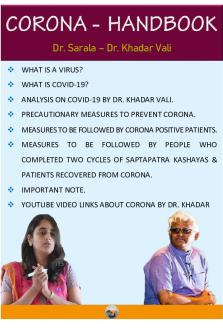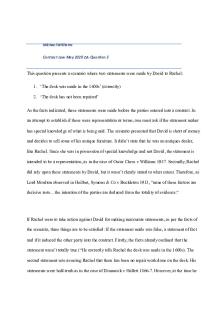Misrepresentation July 2020 ZA Question 3 PDF

| Title | Misrepresentation July 2020 ZA Question 3 |
|---|---|
| Course | Contract law |
| Institution | University of London |
| Pages | 4 |
| File Size | 74.4 KB |
| File Type | |
| Total Downloads | 85 |
| Total Views | 506 |
Summary
Michael Williams Contract Law May 2020 ZA: Question 3This question presents a scenario where two statements were made by David to Rachel: ‘The desk was made in the 1600s’ (correctly) ‘The desk has not been repaired’ As the facts indicated, these statements were made before the parties entered into a...
Description
Michael Williams Contract Law May 2020 ZA: Question 3
This question presents a scenario where two statements were made by David to Rachel: 1. ‘The desk was made in the 1600s’ (correctly) 2. ‘The desk has not been repaired’ As the facts indicated, these statements were made before the parties entered into a contract. In an attempt to establish if these were representation or terms, one must ask if the statement maker has special knowledge of what is being said. The scenario presented that David is short of money and decides to sell some of his antique furniture. It didn’t state that he was an antiques dealer, like Rachel. Since she was in possession of special knowledge and not David, the statement is intended to be a representation, as in the case of Oscar Chess v Williams 1957. Secondly, Rachel did rely upon these statements by David, but it wasn’t clearly stated to what extent. Therefore, as Lord Moulton observed in Heilbut, Symons & Co v Buckleton 1913, “none of these factors are decisive tests…the intention of the parties are deduced from the totality of evidence.”
If Rachel were to take action against David for making inaccurate statements, as per the facts of the scenario, three things are to be satisfied: If the statement made was false, a statement of fact and if it induced the other party into the contract. Firstly, the facts already outlined that the statement wasn’t totally true (“He correctly tells Rachel the desk was made in the 1600s). The second statement was assuring Rachel that there has been no repair work done on the desk. His statements were half-truth as in the case of Dimmock v Hallett 1866-7. However, at the time he
made them, he believed them to be true. The test in Esso Petroleum v Mardon 1976 requires David, the statement maker, to be in a position to know the truth. David was in that position because he was the owner of the desk and should have been able to examine it to ensure that there was no repair work done. The facts also explicitly states that he later discovers the truth before selling the desk to Rachel. Bisset v Wilkinson 1927 suggests that if the statement made was one of opinion, Rachel will not be able to make a claim for misrepresentation. Since the statements made can be proven to be true or false, they were both statements of facts.
The next criteria to be addressed here is if the statement induced Rachel into the contract. The facts presented that Rachel explains to David that antique furniture is less valuable if it has been repaired and David assures her that it had not been repaired. After this, Rachel agrees to the sale. Rachel can prove here that the statements had an effect on her mind by her dialogue with David, as per the case of Museprime Properties v Adhill Properties 1990. It should be noted that Rachel was an Antique dealer and should have been reasonably knowledgeable to check the desk to ensure that the statements made by David was true. She failed to check at that moment, when collecting the desk or even when she had it in her shop, but it would not prevent her reliance on those statements, as in Redgrave v Hurd 1881.
Rachel was induced by the false statements of fact and can therefore make a claim in misrepresentation. It is prudent to begin assessing the facts of the scenario with fraudulent misrepresentation first. Although this is difficult to prove because of the element of dishonesty, the facts state that David remained silent when he discovered that his statement about repair
work was false. The case of Derry v Peek (1889) defined fraudulent misrepresentation as a statement known to be false or a statement made recklessly or carelessly as to the truth of the statement. Similar to the facts here, when David made a statement recklessly, without being certain. He later found out the truth and failed to disclose it to Rachel, which was done in bad faith and is recoverable in Tort of deceit.
In this instance, Rachel will be able to claim for damages and, or rescission. The claimant will be put back into the position before the misrepresentation occurred, meaning, if she chooses to claim damages, she can recover all her loses since remoteness rule does not apply here. However, the court does have discretion to award damages in lieu of rescission. Rachel was unable to sell the desk for six month and the facts continued, “A repaired desk is only worth £2,000.” After paying £20,000 for the desk, under fraudulent misrepresentation she will be able to recover all her loses as in the case of Doyle v Olby (1969).
Rachel may not be able to prove David’s dishonesty, and may therefore seek to bring a claim in negligent misrepresentation where liability may arise under section 2 (1) of the Misrepresentation Act 1967. This less favourable remedy will allow her to only recover foreseeable losses. At the time David made the representations to Rachel, he believed them to be true and as such, he had a burden of proof to be discharged when he later found the representations to be false. If he indeed discharged his burden of proof, she will then have to make her claim under innocent misrepresentation. However, Rachel must prove that the misrepresentation induced her into enter into the contract and as such, David breached his duty to
discharge his burden. Once these can be proven, Rachel will be entitled to damages, however the remoteness rule apply, meaning she will only be able to recover foreseeable losses. Rachel waited six months and the court may see this as a lapse in time, she didn’t act in a reasonable time, as seen in Leaf International Galleries (1950). Also, if the Royscott principle is applicable here, the court will calculate damages as if the statement was fraudulent. This means the remoteness rule will not apply and all Rachel’s losses will be recoverable....
Similar Free PDFs

Econ p1 july 2020
- 12 Pages

Inciter Magazine - July 2020
- 56 Pages

Misrepresentation
- 4 Pages

misrepresentation
- 4 Pages

Misrepresentation
- 5 Pages

Corona Handbook july\'2020
- 8 Pages

Solution MAF651 - JULY 2020
- 9 Pages

Misrepresentation
- 3 Pages
Popular Institutions
- Tinajero National High School - Annex
- Politeknik Caltex Riau
- Yokohama City University
- SGT University
- University of Al-Qadisiyah
- Divine Word College of Vigan
- Techniek College Rotterdam
- Universidade de Santiago
- Universiti Teknologi MARA Cawangan Johor Kampus Pasir Gudang
- Poltekkes Kemenkes Yogyakarta
- Baguio City National High School
- Colegio san marcos
- preparatoria uno
- Centro de Bachillerato Tecnológico Industrial y de Servicios No. 107
- Dalian Maritime University
- Quang Trung Secondary School
- Colegio Tecnológico en Informática
- Corporación Regional de Educación Superior
- Grupo CEDVA
- Dar Al Uloom University
- Centro de Estudios Preuniversitarios de la Universidad Nacional de Ingeniería
- 上智大学
- Aakash International School, Nuna Majara
- San Felipe Neri Catholic School
- Kang Chiao International School - New Taipei City
- Misamis Occidental National High School
- Institución Educativa Escuela Normal Juan Ladrilleros
- Kolehiyo ng Pantukan
- Batanes State College
- Instituto Continental
- Sekolah Menengah Kejuruan Kesehatan Kaltara (Tarakan)
- Colegio de La Inmaculada Concepcion - Cebu







